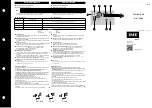
1. FEATURES
• WIDE RANGE OF TRIP LEVEL SETTINGS AND TRIPPING TIME DELAYS
• CAN BE USED WITH INTERNAL OR INTERPOSING EXTERNAL CURRENT SENSOR
• WIDE RANGE AC AND/OR DC CONTROL VOLTAGE
• CONNECTS TO MGARD-SYM REMOTE INDICATOR
-MODBUS CONNECTION TO EXTERNAL NETWORK
-REMOTE DATA COLLECTION
-REMOTE RELAY RESET
-MONITORS UP TO 50 DEVICES ON A SINGLE MODBUS ADDRESS
-ISOLATION PROTECTS YOUR NETWORK
2. INTRODUCTION
The mGARD-100 is a microprocessor-based ground fault relay designed and built to be used on solidly grounded or
resistance grounded systems. This innovative digital electronic relay measures ground fault current using a built-in
2‘’ zero sequence current sensor (ZSCS).
The mGARD-100 reacts to alternating current only and will reject direct current signals. Harmonic filtering can be
enabled using a DIP switch. With the harmonic filtering feature enabled, the mGARD-100 rejects all frequencies
except the fundamental. This can be used to eliminate false tripping when using the relay on systems with
variable frequency drives. With the harmonic filter disabled, the relay will accurately respond to AC currents
between 25 and 400Hz.
By using an interposing current sensor, running the secondary through the mGARD-100 internal ZSCS, the
mGARD-100 can be applied on any system voltage.
The mGARD-100 relay is also available with low voltage DC power supplies including 5V, 12V, 24V and 48V DC.
Other specific ratings are available upon request; please consult I-Gard if other ratings are required.
The output relay has Form “Z” (4 terminal) Normally Open (N.O.) and Normally Closed (N.C.) contacts which may
be used to operate the upstream protective device and to indicate a ground fault in the system. The relay can be
set to operate in any one of the following modes: failsafe; non-failsafe; or auto reset by means of front-accessible
DIP switches.
By double clicking the test/reset button on the unit, a functional test of the mGARD-100 is invoked. A single press of
the remote test/reset button resets the relay after a trip. (It is not necessary to press the test/reset button to invoke
auto reset).




































